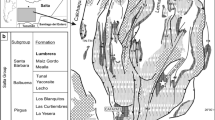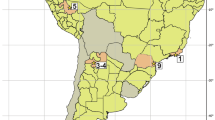Abstract
A new species of the lesser panda, Parailurus baikalicus sp. nov., from the Pliocene of Transbaikalia is described. In contrast to the European taxa P. anglicus and P. hungaricus, it retains a primitive occlusal pattern of M1-M2, with a concave buccal outline, small mesostyle on M1, and undeveloped styles on M2. At the same time, the Transbaikalian panda is more advanced than other representatives of Parailurus in the upper molars with a reduced lingual cingulum and an enlarged paraconule, which is partially (M1) or completely (M2) separated from the protocone. This combination of primitive and advanced characters points to the separation of the Asian branch at the earliest stages of the genus development. The Transbaikalian lesser panda may represent a terminal form of this phylogenetic lineage.
Similar content being viewed by others
References
A. Berzi, J. Mishaux, J. H. Hutchinson, and E. H. Lindsay, “The Arondelli Local Fauna, an Assemblage of Small Vertebrates from the Villafranchian Stage near Villafranca d'Asti, Italy”, Giom. Geol. 35 (2), 1–4 (1967).
O. R. P. Bininda-Emonds, J. L. Gittleman, and A. Purvis, “Building Large Trees by Combining Phylogenetic Information: A Complete Phylogeny of the Extant Carnivora (Mammalia),” Biol. Rev. 74,143-175 (1999).
P. R. Bjork, “The Camivora of the Hagerman Local Fauna (Late Pliocene) of Southwestern Idaho,” Trans. Am. Philos. Sec. 60 (7), 1-54 (1970).
D. Z. Chen and G. Qi, “Human Remains and Mammals Accompanied in Xi Chuo, Yunnan,” Vertebr. Palasiat.16, 35-46 (1978).
W. B. Dawkins, “On Ailurus anglicus, a New Carnivore from Red Crag,” Quart. J. Geol. Sec. London 44, 228231(1888).
J. W. Dragoo and R. L. Honeycutt “Systematics of Mustelid-like Carnivores,” J. Mammal. 78 (2), 426-443 (1997).
M. A. Erbajeva and N. V. Alekseeva, “Neogene Mammalian Sequence of the Eastern Siberia,” Mem. Trav. Inst. Montpellier. EPHE 21, 241-248 (1997).
O. Fejfar, “the Lower Villafranchian Vertebrates from HajnA6ka near Fildkovo in Southern Slovakia,” Rozpr. Ostred. Ost. Geol. 30, 55-59 (1964).
O. Fejfar and M. Sabol, “Pliocene Carnivores (Carnivora, Mammalia) from Ivanovce and HajnASka (Slovakia),” Cour. Forsch. Inst. Senckenberg 246, 15-53 (2004).
J. J. Flynn, M. A. Nedbal, J. W. Dragoo, and R. L. Honeycutt, “Whence the Red Panda?,” Mot. Phylogen. Evol. 17, 190-199 (2000).
T. L. Fulton and C. Sfrobeck, “Molecular Phylogeny of the Arctoidea (Camivora): Effect of Missing Data on Supertree and Super Matrix Analyses of Multiple Gene Data Sets,” Mot. Phylogen. Evol. 41, 165-181 (2006).
L. Ginsburg, “Order Carnivora,” in The Miocene Land Mammals ofEurope (Pfeil, Munchen, 1999), pp. 109-149.
L. Ginsburg, J. Morales, D. Soria, and E. Herraez, “Discovery of an Ancestor of the Lesser Panda in the Middle Miocene of Madrid (Spain),” Earth and Planet. Sci. 325, 447-451 (1997).
J. L. Gittleman, “Are the Pandas Successful Specialists or Evolutionary Failures,” BioScience 44 (7), 456-464 (1994).
R. M. Hunt, “Biogeography of the order Carnivora,” in Carnivore Behavior, Ecology and Evolution (Cornell Univ. Press, Ithaca, 1996), Vol. 2, pp. 485-541.
N. P. Kalmykov, “A New Locality of the Hipparion Mammalian Fauna in Western Transbaikalia,” Byull. Komiss. Izuch. Chetvertich. Per., No. 58, 133-138 (1989).
N. P. Kalmykov and E. N. Maschenko, “Cercopithecidae from the Pliocene of Transbaikalia (Parapresbytis eohanuman),” Vopr. Antropol. 88, 91-114 (1995).
N. P. Kalmykov and VV. Shabunova, “the First Find of an Asiatic Raccoon (Ailurinae: Camivora, Mammalia) in Russia,” in Evolution of Life on the Earth (Tomsk. Gos. Univ., Tomsk, 2005), pp. 293-295 [in Russian].
T. Kormos, “Beitrage zur Kenntnis der Gattung Parailurus,” Mitt. Jahrb. Konig. Ungar. Geol. Anst. 30 (2), 1-39 (1935).
M. Kundrat, “The First Record of the Extinct Lesser Panda Parailurus on Eastern Slovakia,” Natura Carpatica 37, 211-214 (1996).
E. N. Maschenko, “The Northernmost Primate of Asia,” Priroda, No. 11, 64-70 (1994).
M. C. McKenna and S. K. Bell, “Classification of Mammals above the Species Level,” (Columbia Univ. Press, New York, 1997).
M. Morlo and M. Kundrat, “The First Carnivoran Fauna from the Ruscinium (Early Pliocene, MN15) of Germany,” Paleontol. Z. 75, 163-187 (2001).
E. F. Newton, “On Some New Mammals from the Red and Norwich Crags,” Quart. J. Geol. Sec. London 46, 444-453 (1890).
C. A. Repenning, T. R. Weasma, and G. R. Scott, “the Early Pleistocene (Latest Blancan Earliest Irvingtonian) Froman Ferry Fauna and History of the Glenns Ferry Formation, Southwestern Indaho. U.S.,” Geol. Surv. Bull. 2105, 1-86 (1995).
M. S. Roberts and J. L. Gittleman, “Ailurus fulgens,” Mamm. Spec., No. 222,1-8 (1984).
I. Sasagawa, K. Takahachi, T. Sakumoto, et al., “Discovery of the Extinct Red Panda Parailurus (Mammalia, Camivora) in Japan,” J. Vertebr. Paleontol. 23 (4), 895900 (2003).
M. Schlosser, “Parailurus anglicus and Ursus bockhi aus den Ligniten von Bar6th-Kopecz, Comitat Haromszek in Ungarn,” Mitt. Jahrb. Kohnig. Ungar. Geol. Anst. 13,66-95 (1899).
N. Schmidt-Kittler, “Zur Stammesgeschichte der marderverwandten Raubtiergruppen (Musteloidea, Camivora),” Eel. Geol. Helv. 74, 753-801 (1981).
J. P. Slattery and S. J. O'Brien, “Molecular Phylogeny of the Red Panda (Ailurus fulgens),” J. Hered. 86, 413-422 (1995).
M. V. Sotnikova, “On the History of the Genus Gulo in Eurasia,” Tr. Zool. Just. 111, 65-73 (1982).
M. V Sotnikova, “Pliocene Early Pleistocene Camivora Assemblages of Transbaikalian Area, Russia,” in Stratigraphy. Paleontology and Paleoenvironment of Pliocene Pleistocene of Transbaikalia and Interregional Correlations (Ulan-Ude, 2006), pp. 84-85.
M. V Sotnikova and N. P. Kalmykov, “Pliocene Association of Predatory Mammals in the Udunga Locality (Western Transbaikalia),” in Paleogeography and Bios tratigraphy of the Pliocene and Anthropogene (Geol. Just. Ross. Akad. Nauk, Moscow, 1991), pp. 146-159 [in Russian].
A. C. Sowerby, “the Pandas or Cat-bears,” China J. 17, 296-299 (1932).
A. J. Stuart, Pleistocene Vertebrates in the British Isles (Longman. London New York, 1982).
R. H. Tedford and E. P. Gustafson, “First North American Record of the Extinct Panda Parailurus,” Nature 265, 621-623 (1977).
R. H. Tedford, M. F. Skinner, R. W. Fields, et al., “Faunal Succession and Biochronology of the Arikareean through Hemphillian Interval (Late Oligocene through Earliest Pliocene Epochs) in North America,” in Cenozoic Mammals of North America: Geochronology and Biostratigraphy (Univ. California Press, Berkeley, 1987), pp. 153-210.
E. Thenius, “Zur systematischen and phylogenetischen Stellung des BambusWren: Ailuropoda melanoleuca David (Camivora, Mammalia),” Z. Saugetierk. 44 (5), 286-305 (1979).
H. Tobien, “Die oberpliozane Saugerfauna von Wolfersheim-Wetterau,” Z. Geol. Ges. 104,191 (1953).
I. Vislobokova, E. Dmitrieva, and N. Kalmykov, “Artiodactyls from the Late Pliocene of Udunga, Western Trans-Baikal, Russia,” J. Vertebr. Paleont. 15 (1), 146159 (1995a).
I. Vislobokova, M. Sotnikova, and M. Erbajeva, “The Villafranchian Mammalian Faunas of the Asiatic Part of Former USSR,” Ital. J. Quatern. Sci. 8 (2), 367-376 (1995b).
P. B. Vrana, M. C. Milinkovitch, J. R. Powell, and W C. Wheeler, “Higher Level Relationships of the Arctoid Camivora Based on Sequence Data and Total Evidence,” Mot. Phylogen. Evol. 3, 47-58 (1994).
S. C. Wallace and X. Wang, “two New Carnivores from Unusual Forest Biota in Eastern North America,” Nature 431, 256-258 (2004).
X. Wang, “New Cranial Material of Simocyon from China, and Its Implications for Phylogenetic Relationship to the Red Panda (Ailurus),” J. Vertebr. Paleonto1.17 (1), 184-198 (1997).
M. Wolsan, “Phylogeny and Classification of Early European Mustelida (Mammalia: Carnivora),” Acta Thenot. 38 (4), 345-384 (1993).
W C. Wozencraft, “Classification of the Recent Carnivora,” in Carnivore Behavior, Ecology, and Evolution (Cornell Univ. Press, Ithaca, 1989), Vol. 1, pp. 569-593.
A. R. Wyss and J. J. Flynn, “A Phylogenetic Analysis and Definition of the Camivora,” in Mammal Phylogeny (Springer, New York, 1993), pp. 32-52.
Author information
Authors and Affiliations
Corresponding author
Additional information
Original Russian Text © M.V. Sotnikova, 2008, published in Paleontologicheskii Zhurnal, 2008, No. 1, pp. 92–102.
Rights and permissions
About this article
Cite this article
Sotnikova, M.V. A new species of lesser panda Parailurus (Mammalia, Carnivora) from the Pliocene of Transbaikalia (Russia) and some aspects of ailurine phylogeny. Paleontol. J. 42, 90–99 (2008). https://doi.org/10.1134/S0031030108010152
Received:
Published:
Issue Date:
DOI: https://doi.org/10.1134/S0031030108010152




